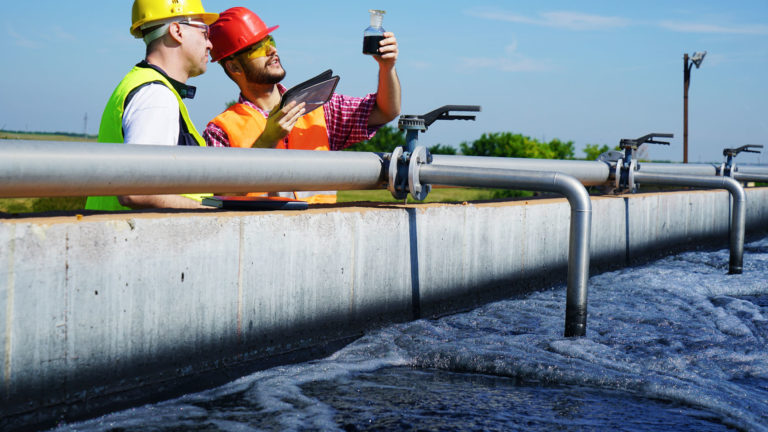Pollution liability cover and contractors

- Who is responsible for environmental pollution?
- History behind environmental impairment liability insurance
- How can you reduce the risk of a pollution claim against you?
- What insurance is available for pollution risks?
Over the last 50 years, the world has become increasingly aware of the role each of us plays in maintaining a healthy planet. National and international laws are holding individuals and corporations responsible for preserving the environment.
As a land or business owner, it can be difficult to establish who is responsible for safe disposal of waste, the management of pollutant risks, and ultimately who pays in the event of a pollution claim. This article explores the risks of contaminated land , responsibilities, and insurance involved when it comes to environmental pollution.
Who is responsible for environmental pollution?
On a fundamental level, liability for pollution rests with the individual or business who produces it. This is the polluter pays principle, which was established in UK legislation within the Environmental Protection Act 1990, shifting the financial burden of pollution clean-up costs from the taxpayer to the polluter.
In the past, cleaning up and dealing with the long-term effects of pollution had been a job for the authorities, with the bill footed by the taxpayer. The polluter pays principle has led to the establishment of carbon taxes, emissions trading, waste disposal licences, and polluters’ liability in the event of accident or negligence.
However where multiple parties are involved in a project, every party has a duty of care to ensure that their business activities do not cause environmental damage. On this basis, if you are a business using a contractor, liability for pollution and waste management is shared between you and the contractor.
History behind environmental impairment liability insurance
Before April 1991, the cost of claims for pollution clean-up and inappropriate waste disposal were typically covered by public liability insurance. However, in light of the stringent rules of liability set out in the Environmental Protection Act, a standard exclusion clause was introduced into most public liability policies. Recommended by the Association of British Insurers (ABI), the new clause excluded liability for gradual pollution.
Public liability insurance still covers pollution caused by a sudden, identifiable, unintended, and unexpected incident, which takes place in its entirety at a specific time and place during the period of insurance and results in a third party damages claim. Many companies choose to bear their environmental liabilities under a public liability policy on this basis. However, this decision can leave businesses unwittingly exposed due to a 2006 High Court decision in Bartoline v Royal Sun Alliance.
Bartoline extension
In 2003, a fire in the Bartoline factory led to a court case that was to highlight the limitations of pollution coverage under public liability insurance.
Bartoline v Royal Sun Alliance (RSA)
Local watercourses were polluted as a result of the fire, and the clean-up costs amounted to approximately £770,000, which the Environment Agency charged to Bartoline. When RSA refused to pay Bartoline’s public liability insurance claim, Bartoline sued the insurance company for alleged breach of contract.
In this case, a distinction was drawn between damages, as set out in Bartoline’s public liability policy, and a debt under statute. The judge ruled that the costs claimed by the Environment Agency, considered a debt under statute, were not covered under Bartoline’s public liability policy, which only covered them for damages.
Since Bartoline v Royal Sun Alliance, public liability insurance providers may offer a statutory clean-up costs extension, more commonly known as a Bartoline extension. However, a public liability policy with the Bartoline extension will still require the pollution to result from a sudden, identifiable incident during the policy period. Businesses therefore would not be covered for any claims made against them for gradual pollution. Neither will the extension cover remediation costs for own-site pollution, biodiversity or operate to address an imminent pollution threat.
These types of claims can be incredibly costly as they can also include the cost of legal defences and interruption to business operations whilst the claim unfolds.
Other instances of liability
- As a commercial property owner who rents the property out to another business, if the tenant (the polluter) is unable to pay for a pollution claim or does not have adequate insurance, the landowner may be pursued instead.
- Businesses can also be held responsible for historical gradual pollution. In an instance where the pollution took place before purchasing the property, but was not discovered until after they became the owner, they would still be held responsible for the cost of a claim.
How can you reduce the risk of a pollution claim against you?
If your business activities include the production of waste, you are ultimately responsible for its safe and legal handling.
In the event of environmental contamination, the law follows the polluter pays principle. Everyone in the waste trail – from producing and storing, to collecting and transporting, to receiving for recycling or disposal – has a duty of care. However, the polluter would be pursued for the cost of a claim in the first instance.
There are steps you can take to reduce the risk of pollution or illegal disposal of waste. Being able to show due diligence can minimise your liability in the event of prosecution.
Audit your contractors
When you employ a contractor to carry out work that creates waste, or to store, transport, or dispose of waste:
- Check your contractor is on the Environment Agency’s public register of waste carriers, brokers, and dealers.
- Check that your contractor holds an industry-specific environmental permit.
- Check the Health and Safety Executive (HSE) register of convictions and notices.
- Check the register of formal cautions and prosecutions by the Environment Agency.
- Ask your contractor where and how they dispose of waste. Check that the waste disposal sites they use meet legal requirements.
- Ensure that your contractor has contractors pollution liability insurance.
- Get a Waste Transfer Note documenting the transfer of waste from one party to another. This document is a legal requirement and should be kept by both parties for two years if it relates to non-hazardous waste. In relation to hazardous waste, the Waste Transfer Note must be kept for three years.
Take copies of all documentary evidence.
For further guidance you can refer to the Environment Agency’s regulations.
Managing your operational activities
Certain business activities have a higher risk of causing environmental pollution than others. The EA lists the following substances as pollutants:
- oil above ground, including petrol, diesel, mineral oil, heating oil or vegetable oil
- petrol in underground tanks
- silage, slurry and agricultural fuel oil
- sheep dip
- pesticides, biocides, herbicides and other chemicals
- solvents
- air pollution
If your business operations include the use or production of any of the above, then following this guidance will help to reduce the risk to the environment and the potential for a hefty clean-up bill coming your way.
- Make a drain plan so that you can check them for blockages, undertake maintenance, and quickly deal with any pollution.
- Install an oil separator. This will separate oil from water that drains from hard surfaces.
- Use good condition storage containers for pollutants. These should be kept in a secure area.
- Correctly decommission any unused storage containers.
- Implement procedures to manage the unloading and moving of pollutants.
- Put together a pollution incident response plan.
- Get permission from the Environment Agency prior to starting work on, near, or over a main river.
- Set up an environmental management system (EMS).
What insurance is available for pollution risks?
Environmental impairment liability (EIL) is the most comprehensive policy available for businesses to protect themselves against the cost of claims for pollution. It has been developed to cover the gaps in both standard public liability wordings and the Bartoline extension, and includes statutory costs payable as a result of gradual or historical pollution.
EIL insurance also covers the costs of:
- Legal defence
- Environmental clean-ups
- Reversal of damage to biodiversity
- Compensation to third-parties for bodily injury or loss of business
- Repair of third-party property
To discuss EIL cover and how this can protect your business, contact Alan Boswell Group on 01603 218000.




